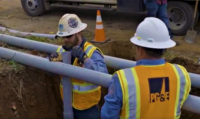On July 1, the California State Geological Survey started mapping the Santa Monica fault in Los Angeles, part of almost 2,000 miles of unmapped fault lines. The project could delineate new earthquake zones and restrict future developments in the state.
CSGS was able to ramp up its mapping efforts weeks after Gov. Jerry Brown (D) signed the state's $156.3-billion budget, which includes $1.49 million this year for fault zoning and $1.3 million in dedicated annual funding. State officials had been under increased pressure to provide fault-line data to developers and local permitting agencies. Program funding had slowly dwindled from the state's general fund and was practically non-existent in 2013, the agency said.
This effort now will be funded by an increase in building permit fees, says Tim McCrink, manager of the Alquist-Priolo fault-line mapping program at CSGS. Current building permit fees of $10 per $100,000 for residential construction and $21 per $100,000 for other construction will be increased by almost 30%.
In 2013, controversy surrounded new developments over faults in California, especially in Los Angeles, where a lawsuit accused a developer and city officials of covering up fault-line data so that a mixed-use tower, the Millennium Hollywood, could receive initial permits from the city. Dana Prevost, the city's geologist, ordered additional testing at the site in May, four months after CSGS released a draft map of the Hollywood fault. The jobsite sits atop an active splay of the fault.
Developer Millennium Partners' website says Delta Group, hired to perform additional trenching and seismic investigations, has found no evidence the splay beneath the site is active. State law defines an "active fault" as having been active in the past 11,000 years, McCrink says.
If CSGS's final version of the Hollywood fault map, expected later this year, still shows the tower sitting atop the fault, the building permit could be denied.
David Cocke, structural engineer for Structural Focus, says, "I can't imagine that the increase in the permit fees will be significant enough to stop a project, but the fault-line investigations will take time … before the final design and construction can be completed."
Before deciding if a development can proceed, the city must review evidence from both the developer and the state geologist. "Once a zone is mapped, the burden of proof is on the developer to prove that its project is not above an active fault," McCrink says.
Engineers will play an active role. "We can advise our clients on whether a differently configured building may help them to resolve the restrictions, but, most importantly, we should design a structure that … meets the owner's and the public's needs and expectations," says McCrink.
Robert P. Silverstein, attorney for a group that sued last year to block the Hollywood tower, says the entire system is flawed. "To permit the city and developer to design, oversee and execute additional seismic testing is like having the fox guard the henhouse," he says. "We want a panel of neutral seismic experts, including California state geologist Dr. John Parrish, to oversee the additional testing. Only then can the public have any confidence in the integrity of the process."


Post a comment to this article
Report Abusive Comment